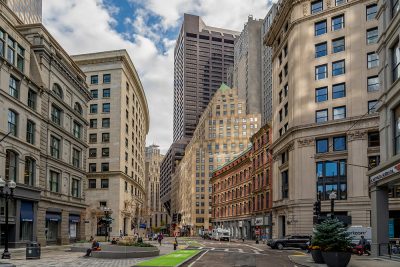
“PLAN: Downtown” is restarting after being shut down in 2020 due to the COVID-19 pandemic. This downtown revitalization plan, created by the City of Boston and the Boston Consulting Group, will attempt to bring vibrancy back to Boston by creating more open spaces, opportunities for small businesses and new housing projects.
The plan has changed since the pandemic, and now there is a greater focus on creating a more equitable and exciting downtown area, according to Mayor Michelle Wu’s report on the project from Oct. 27.
“This report presents a roadmap for a truly inclusive, round-the-clock neighborhood filled with new homes, diverse businesses, world-class public spaces, vibrant nightlife, and a thriving arts and culture scene,” Wu wrote in the report.
The report outlines six key goals for the project: improve vibrancy of office spaces and expand housing downtown, expand the area’s cultural, art, retail, services and hospitality spheres, support connectivity through transportation infrastructure, enhance economic opportunity for underserved populations and grow Boston’s tourism footprint.
“Creating opportunities for people to come back together, to come downtown, to see other people, to see people outside of their neighborhood or their circle is incredibly important,” said Anita Lauricella, senior planner for the Downtown Boston Business Improvement District.
Kenneth Gloss, owner of the Brattle Bookshop, said the demographic has changed since the pandemic, and there are a lot more tourists in the city.
“Now that the people are feeling that they can go to the theater, they can go out to restaurants,” Gloss said. “That also brings a lot more people into the city, but they’re not the office worker people.”
The Downtown Boston Business Improvement District goes from the Boston Common to the Greenway, and from Government Center to Chinatown. Within those 34 blocks, the Boston Business Improvement District works with the city to host events, keep the downtown area clean, work on landscaping projects and keep the community informed about what is happening in the area.
“[The plan] has a nice bucket of projects to be thinking about and that we can start working on right away,” said Lauricella. “It’s a great plan of concrete, tangible actions we can all take together.”
A report done by the City of Boston found that, since the pandemic, more workers hold jobs that could be done remotely, which could decrease the amount of office workers in Boston and leave open office spaces throughout the city.
Gloss said he hopes the City will create new apartments, dormitories or other dwellings from the unused space that will keep people downtown.
“The more people on the street, the more people who care about what the streets are like, how they work, the more businesses that support them, the more restaurants and so on,” said Gloss. “So it’s sort of a vitality.”
The report also found that after the pandemic, foot traffic in the downtown area has stayed about 40-55% below the level it was at before the pandemic, and economic activity downtown has decreased by around 20-40%.
“[The pandemic] reemphasized, for urban centers, the importance of that diversity and opportunity for all sorts of folks,” Lauricella said.“What’s exciting to be looking at this now is how things that we could start to do together again, and to sort of reclaim that energy and the buzz of the downtown area.”
According to the report, compared to other “strategic commercial hubs” in Boston, downtown is the second “whitest” business center. In an already under-represented area, the pandemic hit Black, indigenous and people of color-owned businesses harder than others.
A large part of this revitalization plan is to create better entrepreneurial opportunities for women, BIPOC and other minority populations, the report says.
The goals outlined for this project include equity, resilience and new opportunity.
“What I’m really, as the planner here, very excited about is that the report itself is a great roadmap of possible projects and directions that we can take in working with the city to really enhance the vitality of this part downtown,” said Lauricella.
Its formal relaunch kick-off event will be on Nov. 9 in Downtown Crossing.





















































































































